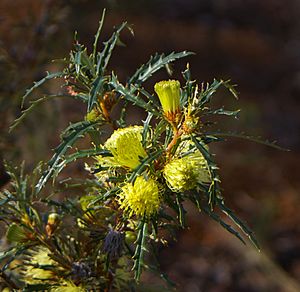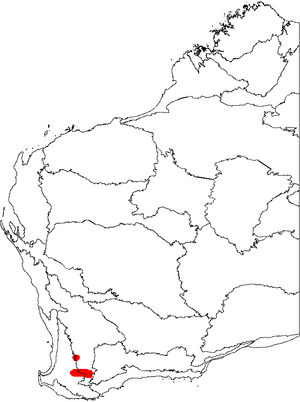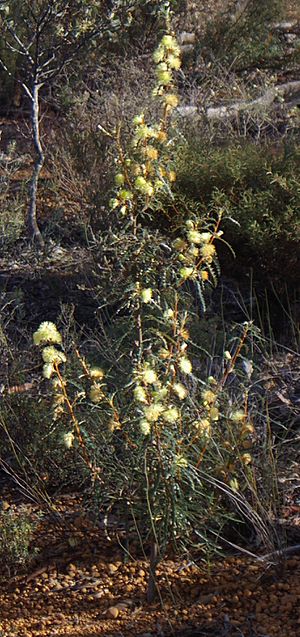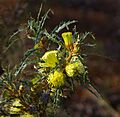Banksia acanthopoda facts for kids
Quick facts for kids Banksia acanthopoda |
|
|---|---|
 |
|
| Conservation status | |
| Scientific classification | |
| Genus: |
Banksia
|
| Species: |
acanthopoda
|
| Synonyms | |
|
|
Banksia acanthopoda is a type of shrub that belongs to the Proteaceae plant family. It grows as a small, spreading bush, usually up to 2 m (6+1⁄2 ft) tall. This plant has spiky leaves and bright yellow flower heads. Each flower head is made up of 50 to 60 tiny yellow flowers grouped closely together.
These flowers bloom during the southern hemisphere winter. Banksia acanthopoda is only found in Western Australia. It grows in a few areas near Woodanilling, Katanning, and Darkan. Because it is quite rare, the Western Australian Department of Environment and Conservation lists it as "Priority Two" for conservation. This means it needs special attention to protect it.
A botanist named Alex George first described this plant in 1996. He called it Dryandra acanthopoda. In 2007, its name was changed to Banksia acanthopoda. This happened when all Dryandra species were moved into the Banksia group. People don't grow this plant much in gardens. It might be sensitive to a plant disease called dieback. Its beautiful flowers could be used in the cut flower industry.
Contents
What it Looks Like
Banksia acanthopoda is a spreading shrub that can grow up to 2 m (6+1⁄2 ft) high. Its young stems are covered with soft, short hairs, but these hairs soon fall off.
The leaves are long, thin, and slightly curved. They have five to ten sharp spines on their stalks, called petioles. The edges of the leaves are sharply jagged, and the leaf tip is pointed. The top side of the leaf is dark green, while the underside is white and hairy. Leaves are usually 5 to 13 cm (2 to 5+1⁄8 in) long and 1 to 1.5 cm (3⁄8 to 5⁄8 in) wide. Their stalks can be up to 1.5 cm (5⁄8 in) long.
The flowers grow on short side branches. They form dense, dome-shaped heads, called inflorescences, which are up to 4 cm (1+1⁄2 in) across. Each head has 50 to 60 yellow flowers packed tightly together. Small leaf-like parts, called involucral bracts, surround the flower head.
Like other Banksia plants, each flower has four connected parts called perianths. Inside, there's a single anther (which holds pollen) and a single pistil (the female part). In B. acanthopoda, both the perianth and pistil are yellow. The perianth is about 2.6 to 3 cm (1 to 1+1⁄8 in) long, and the pistil is a bit longer.
After flowering, the plant forms a woody, dome-shaped structure. This structure holds up to six light brown seed pods, called follicles. Each pod contains one or two seeds.
Banksia acanthopoda looks a bit like B. hewardiana. However, B. acanthopoda has smaller leaves that feel sticky when they are young. Its flower heads are similar to B. squarrosa, but its flower parts are straight and longer, not curved.
How it Got its Name
Scientists started collecting samples of B. acanthopoda a long time ago. For example, Fred Humphreys collected one in 1964. Alex George collected another in 1986.
In 1996, Alex George officially named this plant Dryandra acanthopoda. The name acanthopoda comes from ancient Greek words. Acantha means "thorn" or "prickle." Podos means "foot." This name refers to the spiny parts on the leaf stalks.
At first, George placed B. acanthopoda in the Dryandra group. He thought its closest relative was Dryandra polycephala, which is now called Banksia polycephala.
In 2007, two botanists, Austin Mast and Kevin Thiele, made a big change. They decided that all Dryandra species should be moved into the Banksia group. This meant Dryandra acanthopoda became Banksia acanthopoda. This change helped simplify how these plants are grouped. So now, B. acanthopoda is part of the Banksia subgenus and the Dryandra series.
Where it Lives
Banksia acanthopoda is quite rare, with only a few small groups of plants. For a long time, people thought it only grew in the Avon Wheatbelt area of Western Australia. This was around Woodanilling and Katanning.
However, a new group of plants was found in the Jarrah Forest area, south of Darkan. This discovery expanded its known range.
Banksia acanthopoda likes to grow in a type of dense shrubland called kwongan heath. It prefers soils that are rich in iron, called lateritic soils. Sometimes, it grows under a few scattered wandoo trees (Eucalyptus wandoo) or Drummond's gum trees (Eucalyptus drummondii).
Other Banksia plants that grow in the same areas include B. stuposa, B. armata var. ignicida, and B. nobilis. The climate in these areas is usually between 9 to 22 °C (48 to 72 °F). It can get hotter than 30 °C (86 °F) for up to 40 days a year. The area gets about 400 to 500 mm (16 to 20 in) of rain each year.
Plant Life and Threats
Not much is known about how Banksia acanthopoda lives in the wild. It flowers from May to July. Its seeds are released every year.
When it was first discovered, Banksia acanthopoda was listed as "Priority Three" for conservation. This meant it was a "Poorly Known Taxa." Now, it has been moved to "Priority Two." This means it is still poorly known but faces more serious threats.
The threats to this plant depend on where it grows. In the Avon Wheatbelt, much of the land has been cleared for farming. Here, the plant faces several dangers:
- Habitat loss: Land clearing and salty soil (salinity) destroy where it lives.
- Population fragmentation: When its habitat is broken up, the plant groups become separated. This can reduce their genetic diversity.
- Grazing: Animals eating the plants can harm them.
- Weeds: Non-native plants can compete with Banksia acanthopoda for resources.
- Fire: Changes in how often fires happen can wipe out whole generations of plants.
Further west, in the Jarrah Forest, the main threat is plant diseases, especially pathogens.
Scientists are still learning about how easily Banksia acanthopoda gets sick from dieback disease. One report from 2006 said it was "highly susceptible." However, this information might have been confused with another similar plant.
Good news for its survival: studies show that B. acanthopoda seeds can be stored for a long time. After six years in a special seed bank, 90% of the seeds still grew successfully. This is similar to how fresh seeds grow.
Growing this Plant
Banksia acanthopoda is not commonly grown in gardens. However, it has been successfully grown at The Banksia Farm in Mount Barker, Western Australia. It also grows at the Royal Botanic Gardens in Cranbourne, Melbourne.
This plant can be a bit sprawling and untidy. But you can make it look better by carefully trimming it. Its bright yellow flowers appear from July to October when grown in gardens. These flowers could be popular for use in the cut flower industry.
To grow Banksia acanthopoda, it needs soil that drains water well. It prefers full sun or a little bit of shade. Once it's established, it can handle dry conditions. You can grow new plants from seeds. The seeds usually sprout in three to five weeks, and about 80 to 90 percent of them will grow into new plants.
Images for kids
See also
 In Spanish: Banksia acanthopoda para niños
In Spanish: Banksia acanthopoda para niños





